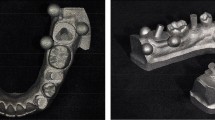Abstract
Purpose
Most software systems for oral implantology are based on a two-dimensional multi-view approach, often accompanied with a surface rendered model. Usually they are affected by common errors like anisotropy of the volume and distortion on measurements. A more integrated and realistic 3D approach for implant surgery is desirable in order to gain a deeper and surer knowledge of patient’s anatomy before inserting the implants, thus reducing the risk of damaging surrounding structures.
Methods
We present a 3D software system for oral implant planning where computer graphic techniques have been used to create a smooth and user-friendly fully integrated 3D environment to work in. Both volume isotropy and correctness in measurements are obtained through slices interpolation to achieve, respectively, an isotropic voxel and the freedom of choosing arbitrarily, during the planning, the best cross-sectional plane. Correct orientation of the planned implants is also easily computed, by exploiting a radiological mask with radio-opaque markers, worn by the patient during the CT scan.
Results
Precision in measures was validated by considering several different scans and comparing the measures achieved with the ones got through the common methodology. It has been also calculated error percentages, algorithms efficiencies, and performances. Precision achieved outperforms usual DentaScan multi-view approach one, and it is comparable with or better than that obtained by the DentalVox tool (from 0.16 to 0.71% error in measures).
Conclusions
The proposed software system provides a user-friendly, correct and precise work context for oral implant planning, avoiding similar software common errors. The 3D environment can be also exploited in the final surgical phase, in order to provide a flapless surgical guide, through the use of an anthropomorphic robot.
Similar content being viewed by others
References
GE Medical Systems, “DentaScan” (http://www.gehealthcare.com/usen/ct/clin_app/products/dscan.html). home page at: http://www.gehealthcare.com
Materialise, “SurgiCase” and “SimPlant”. home page at: http://www.materialise.com
Praxim, “CAD Implant”. home page at: http://www.praxim.fr
Cucchiara R et al (2001) Enhancing implant surgery planning via computerized image processing. Int J Comput Dent 4(1): 9–24
Cucchiara R, Lamma E, Sansoni T (2004) An image analysis approach for automatically re-orienteering CT images for dental implants. Comput Med Imaging Graphics 28(4): 185–201
Verstreken K, Van Cleynenbreugel J, Martens K, Marchal G, Steenberghe D, Suetens P (1998) An image-guided planning system for endosseous oral implants. IEEE Trans Med Imaging 17(5): 842–852
Verstreken K, Van Cleynenbreugel J, Marchal G, Naert I, Suetens P, Steenberghe D (1996) Computer-assisted planning of oral implant surgery: a three-dimensional approach. Int J Oral Maxillofac Implant 11(6): 806–810
Van Assche N, van Steenberghe D, Guerrero ME, Hirsch E, Schutyser F, Quirynen M, Jacobs R (2007) Accuracy of implant placement based on pre-surgical planning of three-dimensional cone-beam images: a pilot study. J Clin Periodontol 34(9):816–821(6)
Jacobs R, Adriansens A, Verstreken K, Suetens P, van Steenberghe D (1999) Predictability of a three-dimensional planning system for oral implant surgery. Dentomaxillofac Radiol 28(2): 105–111
Kusumoto N, Sohmura T, Yamada S, Wakabayashi K, Nakamura T, Yatani H (2006) Application of virtual reality force feedback haptic device for oral implant surgery. Clin Oral Implant Res 17(6): 708–713
med 3D, “implant3D” and “X1med3D”. home page at: http://www.med3D.de/en/start_en.html
IVS Solutions, “coDiagnostiX” and “gonyX”. home page at: http://www.ivs-solutions.de/
Lorensen WE, Cline HE (1987) Marching cubes: a high resolution 3D surface construction algorithm. Comput Graphics 21(4): 163–169
Author information
Authors and Affiliations
Corresponding author
Rights and permissions
About this article
Cite this article
Chiarelli, T., Lamma, E. & Sansoni, T. A fully 3D work context for oral implant planning and simulation. Int J CARS 5, 57–67 (2010). https://doi.org/10.1007/s11548-009-0394-y
Received:
Accepted:
Published:
Issue Date:
DOI: https://doi.org/10.1007/s11548-009-0394-y




